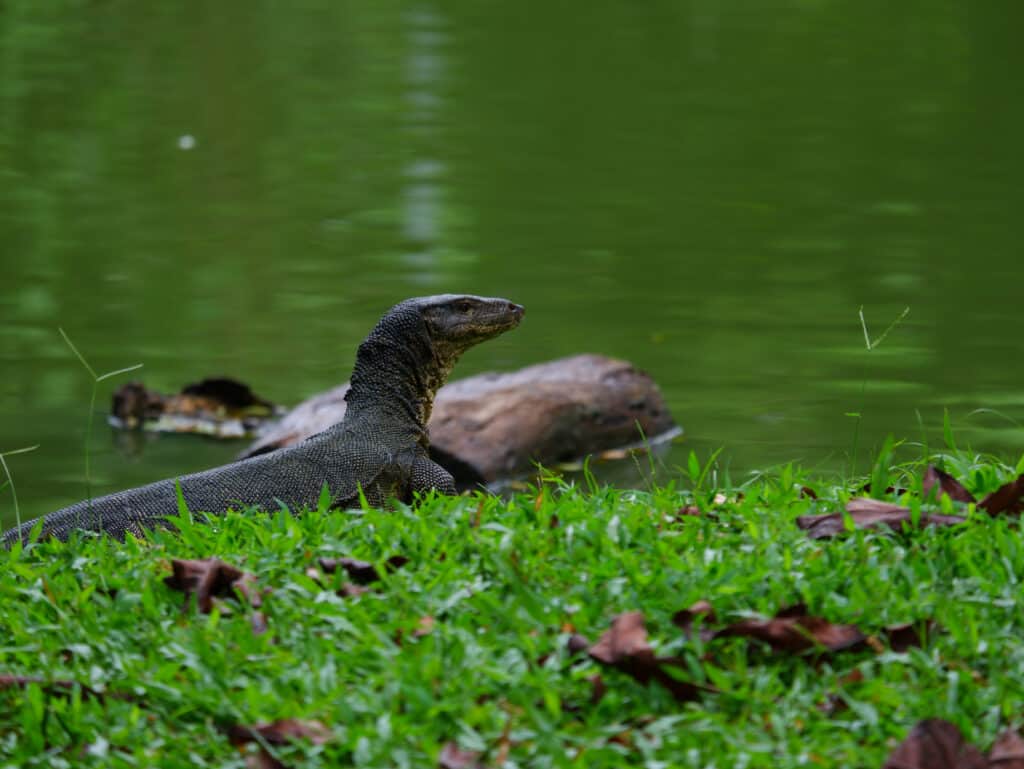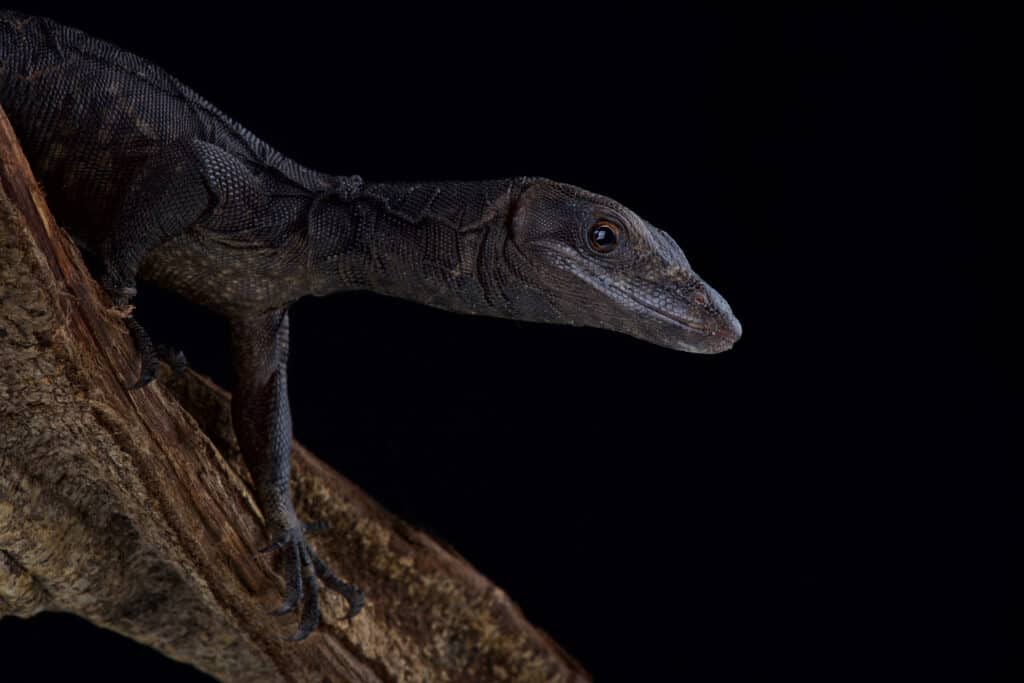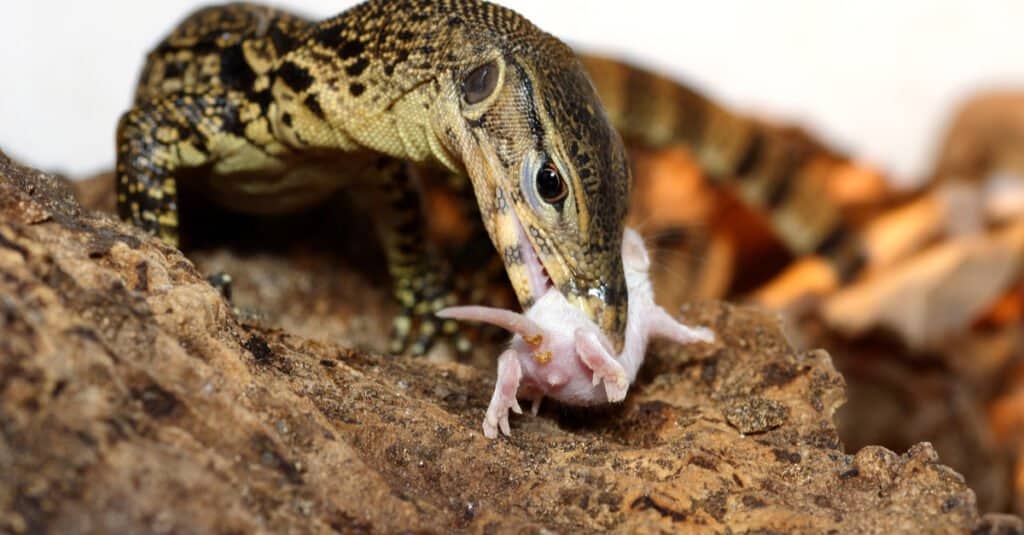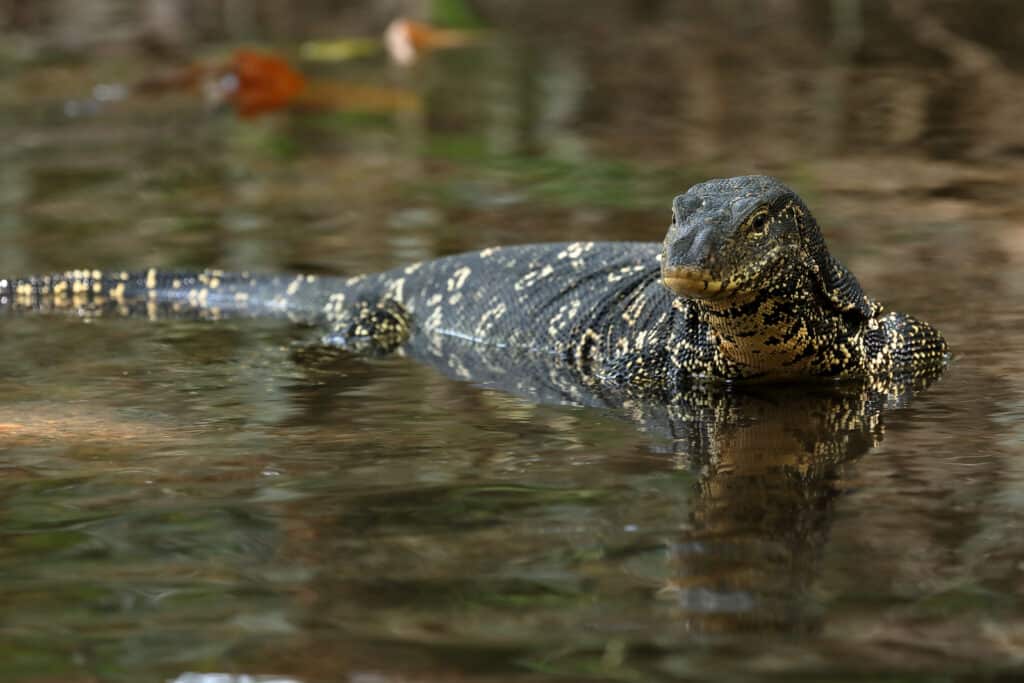Monitor lizards, including the famous Komodo dragon, are ferocious creatures. The Asian water monitor is no exception. This article will explore several interesting facets of the Asian water monitor’s biology, history, and geography. Read on for everything you need to know about the Asian water monitor.
Taxonomy and Evolution

The Asian water monitor lizard relies more on aquatic environments than other monitor species.
©MH Capture/Shutterstock.com
The Asian water monitor, scientifically known as Varanus salvator, is a fascinating reptilian species. As such, it falls under the class Reptilia, which encompasses a wide array of cold-blooded, scaly vertebrates. Within the reptile class, Asian water monitors belong to the family Varanidae, commonly referred to as monitor lizards. This family includes some of the largest and most iconic lizard species globally, known for their robust build, powerful jaws, and keen predatory instincts. In fact, the world’s largest extant lizard, the Komodo dragon, is a type of monitor lizard.
In the grand scheme of reptile taxonomy, monitor lizards are all within one order, Squamata. Squamata includes not only lizards but also snakes. This order is nested within the class Reptilia, where reptiles are categorized alongside other remarkable groups like turtles, crocodilians, and birds. Monitor lizards demonstrate the diverse and captivating array of life forms that have evolved within the reptile class over millions of years.
Subspecies
Within the Varanus salvator species (Asian water monitors) there are several recognized subspecies. Each is adapted to a particular geographic region. The five commonly recognized subspecies are:
- The nominate subspecies-Varanus salvator salvator
- The Andaman Islands water monitor- Varanus salvator andamanensis
- The two-striped water monitor- Varanus salvator bivittatus
- The Southeast Asian water monitor- Varanus salvator macromaculatus
- Ziegler’s water monitor- Varanus salvator ziegleri

The black water monitor is solid black due to a genetic mutation but is the same subspecies as the Southeast Asian water monitor,
Varanus salvator macromaculatus.
©reptiles4all/Shutterstock.com
The taxonomy of monitor lizard species and subspecies is an ongoing discussion that changes as new scientific evidence becomes available. For example, Varanus cumingi, Varanus marmoratus, Varanus mabitang, and Varanus nuchalis were previously regarded as subspecies of Asian water monitor but were later determined to be distinct species. Also, the black water monitor of Thailand is now regarded as a melanistic population of the Southeast Asian water monitor, not another subspecies.
Distribution
Geography
The Asian water monitor boasts an extensive and diverse geographic distribution throughout Southeast Asia and adjacent regions. These adaptable lizards are prevalent in countries such as India, Sri Lanka, Bangladesh, Myanmar, Thailand, Cambodia, Vietnam, Laos, Malaysia, Singapore, Indonesia, the Philippines, and parts of southern China. Their distribution extends from the Indian subcontinent to the Malay Peninsula, the Indonesian archipelago, and numerous nearby islands.
Habitat Preferences

Swamps are crucial ecosystems that act as reservoirs for the surrounding area and help moderate the effects of flooding. Asian monitor lizards are one of many animal species that thrive in aquatic environments like swamps.
©jaimie tuchman/Shutterstock.com
Water monitors are incredibly versatile, occupying environments ranging from coastal mangroves, swamps, and riversides to tropical rainforests, agricultural areas, and even urban locales. Their ability to adapt to such diverse surroundings has contributed to their wide distribution and success in the wild. While the precise range of individual subspecies may vary, collectively, Varanus salvator showcases the rich biodiversity of Southeast Asian ecosystems. It also underscores the lizard’s role as a top predator in the region.
Diet

Asian water monitors have powerful jaws and serrated teeth that are adapted for tearing animal flesh.
©iStock.com/Vidu Gunaratna
Asian water monitors are opportunistic predators with a broad diet, playing important roles in the ecosystems they inhabit. Their feeding habits are diverse and adaptable, making them top predators in their habitats.
Asian water monitors are carnivorous reptiles, and their diet primarily consists of animal matter. They are skilled hunters and scavengers, which allows them to exploit various food sources. Their diet can include fish, amphibians, crustaceans, birds, small mammals, reptiles, and even carrion. In some ecosystems, Asian water monitors are known to prey on the eggs and young of birds, reptiles, and even crocodiles. This behavior can have significant impacts on local populations of nesting animals.
In addition, their semi-aquatic lifestyle is a key feature of their feeding behavior. They are proficient swimmers and can dive underwater to catch prey, including fish and aquatic invertebrates. This is unique from some other monitor lizards. Their strong jaws and sharp teeth make them effective at capturing and consuming aquatic prey.
Reproduction
Asian water monitors typically engage in a polygynous mating system, where a single dominant male often mates with multiple females in his territory. During the breeding season, males engage in intense competition for access to females, which can involve aggressive displays, combat, and territorial behaviors. The dominant males establish territories that encompass suitable nesting sites, water sources, and abundant food, which can attract receptive females.
These lizards are oviparous, meaning they lay eggs rather than giving birth to live young. After successful mating, female Asian water monitors undergo a gestation period that can last for approximately two to three months, depending on environmental conditions such as temperature and humidity. The exact timing of egg-laying can vary within the species’ wide geographic range.
When they do lay their eggs, the clutch size typically ranges from 20 to 50 eggs, although larger clutches have been reported. The size of the clutch may depend on the female’s age, health, and environmental factors. Once the female has selected a suitable nesting site, she excavates a burrow to deposit her eggs.
Although Asian water monitors have large clutch sizes, the hatching success and survival of Asian water monitor hatchlings can be challenging. Many factors contribute to infant mortality, including predation by various animals, exposure to environmental hazards, and competition among hatchlings. Only a fraction of hatchlings will survive to adulthood, which highlights the importance of producing large clutches to increase the chances of some offspring reaching maturity. This is an evolutionary phenomenon also present in sea turtle species. For example, the record for largest clutch of leatherback sea turtle eggs is approximately 238!
Development
The early development of Asian water monitors has several distinct stages as they progress from hatching to sexual maturity. These stages involve a combination of parental care, self-sufficiency, and unique adaptations.

Juvenile Asian water monitors develop hunting skills as they become more self-sufficient.
©Valt Ahyppo/Shutterstock.com
- Hatching: After an incubation period of approximately two to three months, Asian water monitor eggs hatch. Hatchlings emerge from their underground nests and are highly vulnerable to predation during this phase. They depend entirely on their mother for protection and guidance in their early days.
- Maternal Care: Female Asian water monitors are known to exhibit maternal care, at least in the initial stages of their offspring’s lives. The mother guards her nest and hatchlings, helping them to thermoregulate by digging or adding substrate to the nest to adjust temperature and humidity. She may also assist in digging the hatchlings out of the nest if needed.
- Dependence and Weaning: Asian water monitor hatchlings are initially dependent on their mother for food. They often consume insects, small invertebrates, and perhaps even small vertebrates she provides. However, as they grow, they gradually become more independent, and the mother’s role in provisioning and protection diminishes.
- Self-Sufficiency: Juvenile Asian water monitors begin to forage for food on their own as they grow larger and more capable. They explore their environment and learn to hunt various prey, expanding their diet beyond what their mother offers. During this stage, they develop the hunting skills necessary for their survival.
- Sexual Maturity: The age at which these monitors reach sexual maturity can vary depending on several factors, including environmental conditions and food availability. Typically, males reach sexual maturity at around 2 to 3 years of age, while females may take longer, often reaching maturity between 3 and 4 years old.
Adaptations
Asian water monitors exhibit several remarkable adaptations that have evolved over time, contributing to their success as a species in their diverse and challenging environments.

These lizards are uniquely adept in aquatic environments and can hunt very effectively in water.
©iStock.com/heckepics
One notable adaptation is their strong semi-aquatic lifestyle. These monitors are excellent swimmers, possessing a flattened tail and webbed feet that aid in propulsion through the water. This adaptation allows them to access various aquatic habitats like rivers, ponds, and mangroves, where they can find abundant prey and escape terrestrial predators. Through evolutionary time, this aquatic prowess has provided them with a distinct advantage in terms of foraging efficiency and predator avoidance.
Another fascinating adaptation is their sharp, serrated teeth and powerful jaws. Asian water monitors have evolved these formidable dental structures to capture and consume a wide range of prey. This includes fish, birds, and mammals. The serrations on their teeth enable them to grip and hold onto struggling prey, preventing escape. This adaptation is crucial for their survival as top predators and enables them to secure a diverse and energy-rich diet. Their ability to hunt in water and on land allows them to exploit a wide range of ecological niches. This is a major factor that contributes to their continued evolutionary success.
The photo featured at the top of this post is © iStock.com/heckepics
Thank you for reading! Have some feedback for us? Contact the AZ Animals editorial team.







